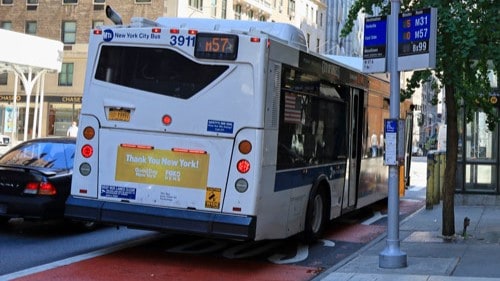At a glance
This module helps users to assess plans, policies, environments, and resources devoted to public transportation. This may include public transit infrastructure and access.

About this module
Who should be involved: Technical experts with knowledge of the community's planning, transportation, and public transit plans, policies, and resources. This specifically includes experts in:
- Planning
- Transportation
- Public transit
Time to complete: It will take approximately 30 minutes to complete Module 3.
Terms and definitions
Branches: Various forks in the transit network. Also refers to which are main lines and which are less well served.
Bus stop siting: Relates to whether there are bus stops at all, as well as where the stops are located.
Bus stop spacing: Relates to correct spacing between bus stops. If stops are too infrequent, people will not walk that far. If stops are too close together, physical activity is limited because buses stop frequently.
Fleet: A number of vehicles operating together or under the same ownership.
General Transit Feed Specification (GTFS): A format to describe public transportation schedules and associated geographic information for fixed-route transit services. Information may include:
- Stops.
- Routes.
- Schedules.
- Calendars.
- Fares.
- Other elements.
GTFS is typically used to supply data on public transit for use in multimodal trip planning applications.
Health disparities: Particular types of health differences closely linked with social, economic, and/or environmental disadvantage. Health disparities negatively affect groups of people who have systematically experienced greater obstacles to health and/or clean environments based on their:
- Racial or ethnic group.
- Religion.
- Socioeconomic status.
- Gender.
- Age.
- Mental health.
- Cognitive, sensory, or physical disability.
- Sexual orientation or gender identity.
- Geographic location.
- Other characteristics historically linked to discrimination or exclusion.
Health equity: When everyone has the opportunity to be as healthy as possible.
Intelligent transportation system: An application to provide services relating to different modes of transport and traffic management. Transmits real-time information, enabling users to make better use of transportation networks.
Level boarding: A system that places boarding platforms on the same level as the floor of the bus.
Multimodal: Refers to the availability of multiple transportation options, especially within a system or corridor. A multimodal approach to transportation planning focuses on the most efficient way to get people or goods from place to place using transportation methods other than privately owned vehicles. For example, this may include traveling by any of these:
- Bus.
- Trolley.
- Light rail.
- Streetcar.
- Cable car.
- Ferry system.
Network connectivity: Trunklines—main branches in the transit network—connect key hubs, making travel between dense centers quick and simple. On a network of high-frequency routes with predictable, rapid-style service, people can make more trips more quickly. If riders can transfer conveniently along the grid network with minimal added trip time, the network can connect more destinations.
Transit-oriented development: A type of urban development that maximizes the amount of residential, business, and leisure space within walking distance of public transportation.
Transit facility: A place that provides access to transit services. This includes, but is not limited to:
- Transit stations.
- Bus stops.
- Bus stations.
- Highway interchanges used by one or more transit providers.
- Ferry landings.
- Train stations.
- Bus rapid transit stops.
Transit infrastructure: Primary components of a public transportation system. This includes:
- Equipment, such as fare card machines, real time arrival displays, wheelchair lifts, elevators, and bus shelters.
- Facilities, such as transit stations, bus stops, train tracks, and transit station amenities.
- Vehicles, such as trains, streetcars, buses, and ferries.
Transit service area: A measure of access to transit service in terms of population served and area coverage in square miles.
